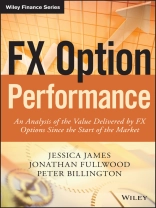Get the little known – yet crucial – facts about FX options
Daily turnover in FX options is an estimated U.S. $ 207 billion, but many fundamental facts about this huge and liquid market are generally unknown. FX Option Performance provides the information practitioners need to be more effective in the market, with detailed, specific guidance.
This book is a unique and practical guide to option trading, with the courage to report how much these contracts have really made or lost. Breaking free from the typical focus on theories and generalities, this book gets specific – travelling back in history to show exactly how options performed in different markets and thereby helping investors and hedgers alike make more informed decisions. Not overly technical, the rigorous approach remains accessible to anyone with an interest in the area, showing investors where to look for value and helping corporations hedge their FX exposures. FX Option Performance begins with a quick and practical introduction to the FX option market, then provides specific advice toward structures, performance, rate fluctuation, and trading strategies.
* Examine the historical payoffs to the most popular and liquidly traded options
* Learn which options are overvalued and which are undervalued
* Discover surprising, generally unpublished facts about emerging markets
* Examine systemic option trading strategies to find what works and what doesn’t
On average, do options result in profit, loss, or breaking even? How can corporations more cost-effectively hedge their exposure to emerging markets? Are cheap out-of-the-money options worth it?
İçerik tablosu
About the Authors xi
CHAPTER 1 Introduction 1
1.1 Why Read This Book? 1
1.2 This Book 3
1.3 What Is an FX Option? 3
1.4 Market Participants 5
1.4.1 How Hedgers Can Use This Information 6
1.4.2 How Investors Can Use This Information 7
1.5 History and Size of the FX Option Market 9
1.6 The FX Option Trading Day 14
1.7 Summary 14
References 14
CHAPTER 2 The FX Option Market: How Options Are Traded and What That Implies for Option Value 17
2.1 Introduction 17
2.2 The Basics of Option Pricing 18
2.2.1 The Black-Scholes-Merton Model 18
2.2.2 The Impact of Volatility 20
2.2.3 The Impact of Rate Differentials 21
2.3 How Options Are Traded 22
2.3.1 Two Views of Volatility 23
2.3.2 Static Trading 24
2.3.3 Dynamic Trading 24
2.4 A More Detailed Discussion of Option Trading 26
2.4.1 The Greeks 26
2.5 Summary 31
References 31
CHAPTER 3 It Is All About the Data 33
3.1 Introduction 33
3.2 The Goal: To Price Lots of Options! 34
3.3 Defining a Universe of Currencies 34
3.4 The Data 37
3.4.1 Pricing Model Data Requirements 38
3.4.2 Sourcing the Data 39
3.4.3 Calculation Frequency 40
3.4.4 Currency of Option Notional Amount 41
3.4.5 Spot Market Value 42
3.5 Limitations 43
3.6 Summary 45
References 45
CHAPTER 4 At-the-Money-Forward (ATMF) Options 47
4.1 What Are ATMF Options? 47
4.1.1 How Are ATMF Options Used and Traded? 47
4.1.2 What Is the ‘Fair’ Price for an ATMF Option? 48
4.2 How Might Mispricings Arise? 50
4.2.1 Can the Forward Rate Be on Average Wrong? 51
4.2.2 Can the Implied Volatility Be on Average Wrong? 52
4.2.3 Simple Example with USDJPY 53
4.3 Results for Straddles for All Currency Pairs 55
4.3.1 Discussion of Results for Straddles 57
4.3.2 A Breakdown of the Results by Currency Pair 62
4.3.3 Drilling Down to Different Time Periods 62
4.3.4 Comparison of Put and Call Options 64
4.4 Have We Found a Trading Strategy? 75
4.5 Summary of Results 76
References 76
CHAPTER 5 Out-of-the-Money (OTM) Options: Do Supposedly ‘Cheap’ OTM Options Offer Good Value? 77
5.1 Introduction 77
5.2 Price versus Value 78
5.3 The Implied Volatility Surface 79
5.4 Why Do Volatility Surfaces Look Like They Do? 80
5.4.1 Equity Indices 80
5.4.2 Foreign Exchange Markets 83
5.5 Parameterising the Volatility Smile 84
5.6 Measuring Relative Value in ATMF and OTM Foreign Exchange Options 88
5.6.1 The Analysis 89
5.6.2 Option Premium 90
5.6.3 Option Payoff 90
5.6.4 Payoff-to-Premium Ratios 90
5.6.5 Discussion 95
5.6.6 Alternative Measures of OTM Option Worth 96
5.7 Summary 97
Reference 97
CHAPTER 6 G10 vs EM Currency Pairs 99
6.1 Why Consider EM and G10 Options Separately? 99
6.2 How Would EM FX Options Be Used? 99
6.3 Straddle Results 100
6.3.1 Comparison of ATMF Put and Call Options 103
6.3.2 Comparison of OTM Put and Call Options 106
6.3.3 The Effect of Tenor 111
6.4 Hedging with Forwards vs Hedging with Options 113
6.5 Summary of Results 120
CHAPTER 7 Trading Strategies 123
7.1 Introduction 123
7.2 History of the Carry Trade 123
7.3 Theory 124
7.4 G10 Carry Trade Results 125
7.5 EM Carry Trade Results 130
7.6 What Is Going On? 131
7.7 Option Trading Strategies – Buying Puts 132
7.8 Option Trading Strategies – Selling Calls 136
7.9 Option Trading Strategies – Trading Carry with Options 140
7.9.1 Premium and Payoff vs MTM Calculations 144
7.10 Summary of Results 146
References 147
CHAPTER 8 Summary 149
8.1 A Call to Arms 149
8.2 Summary of Results from This Book 150
8.3 Building up a Picture 151
8.3.1 What Does This Mean in Practice? 155
8.4 Final Word 156
Appendix 157
Glossary 241
Index 247
Yazar hakkında
JESSICA JAMES is Head of the FX Quantitative Solutions team at Commerzbank in London. She was formerly with Citigroup and held a number of FX roles, latterly
as Global Head of the Quantitative Investor Solutions Group.
JONATHAN FULLWOOD is a Director in FX Quantitative Solutions at Commerzbank in London. He has also worked in fixed income research and portfolio
strategy roles.
PETER BILLINGTON is Global Head of FX Exotic Option Trading at Uni Credit in London. Since 1993 he has worked in FX option trading roles for Standard
Chartered Bank and BNP Paribas and been Global Head of FX Trading at Commerzbank.












